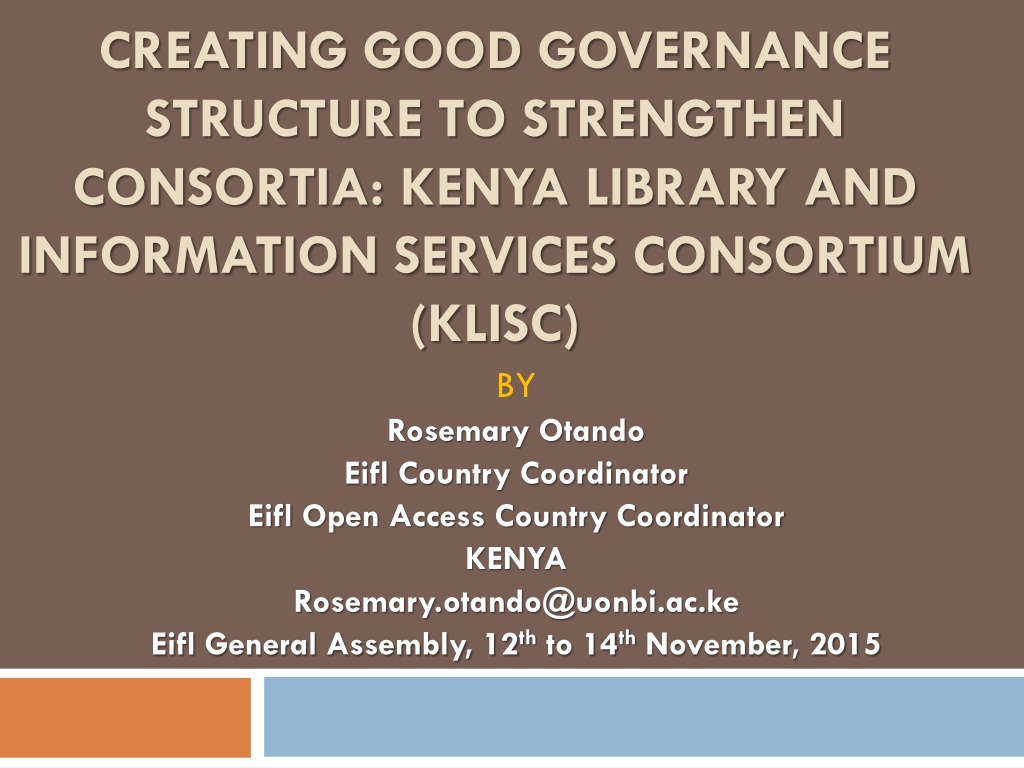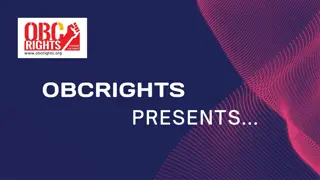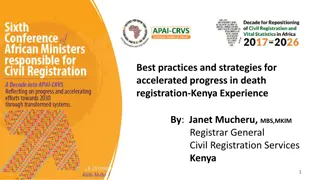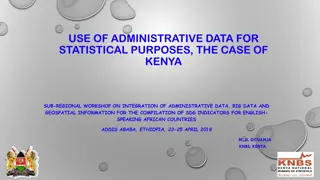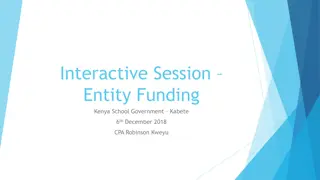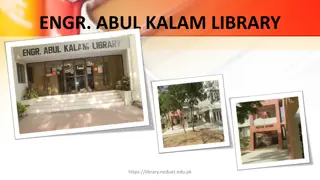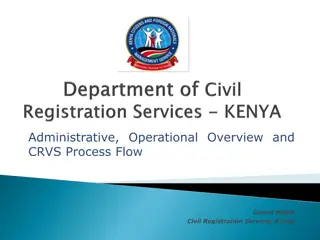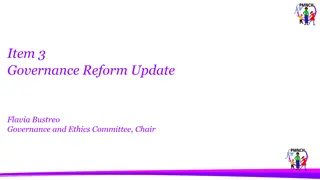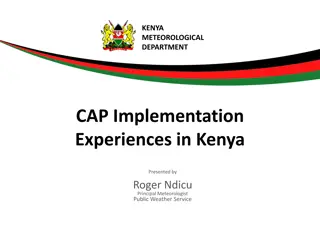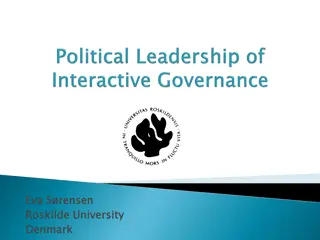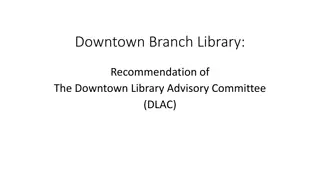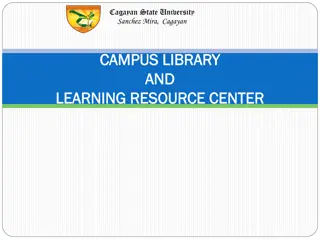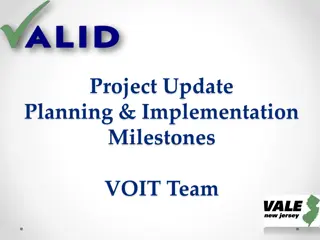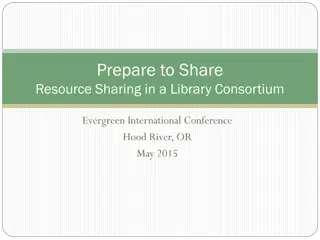Strengthening Governance Structure for Kenya Library and Information Services Consortium (KLISC)
Developing good governance structures is vital for the success and sustainability of consortia like KLISC. Established in 2003, KLISC aims to share resources, enhance information dissemination, and promote ICT usage in Kenya. The executive structure, objectives, and strategies employed demonstrate a commitment to achieving these goals and fostering collaboration among members.
Download Presentation

Please find below an Image/Link to download the presentation.
The content on the website is provided AS IS for your information and personal use only. It may not be sold, licensed, or shared on other websites without obtaining consent from the author. Download presentation by click this link. If you encounter any issues during the download, it is possible that the publisher has removed the file from their server.
E N D
Presentation Transcript
CREATING GOOD GOVERNANCE STRUCTURE TO STRENGTHEN CONSORTIA: KENYA LIBRARY AND INFORMATION SERVICES CONSORTIUM (KLISC) BY Rosemary Otando Eifl Country Coordinator Eifl Open Access Country Coordinator KENYA Rosemary.otando@uonbi.ac.ke Eifl General Assembly, 12thto 14thNovember, 2015
What is KLISC? Consortium formed to share the costs of subscription of PERI e- resources and later any other databases evaluated and acceptable by the Consortium University of Nairobi (UoN) agreed to host KLISC until such a time that it is able to stand on its own 2003-2010 University of Nairobi acted as National Coordinator for KLISC 2010- 2014 Interim Executive selected by Members 2013 - Strategic Plan development and revision of Constitution done which paved way for the Interim Executive being confirmed as Executive Committee in 2014. To date, University of Nairobi still hosts KLISC
KLISC EXECUTIVE STRUCTURE 2014- to date Interim confirmed in 2014 AGM for a period of 3 years. This was after two workshops funded by INASP to support the development of Strategic Plan and workshop on Strengthening of the Consortium . Aim was to support KLISC to be more Independent Executive Chair, Vice Chair, Secretary, Treasurer, 3 other members to manage the Consortium All are Managers in various Libraries (Library Directors and Deputy Library Directors) Next Election 2017 - Executives to be elected by Members as per the Constitution Country Coordinators - for INASP & Eifl, selected by Executive Working Committees was formed by the Executive in 2014 to coordinate KLISC activities
KLISC OBJECTIVES Launched in 2003; Objectives Members Public Universities To enhance dissemination of information for national development To share information resources in stock Private Universities Government Institutions/Departments Public Libraries, National Archives, Museums, etc. To facilitate capacity building in libraries and information centers in Kenya To promote development of local content Non-Profit National Tertiary Colleges To promote the use of ICTs in information management National Research Institutions
STRATEGIES USED Strong Executive structure in place with functions clearly stated Quarterly meetings of the executive to assess achievements Strategic plan and the constitution implementation Capacity building e.g. consortium strengthening workshops, Website development for communication and visibility Mentorship staff attached in developed libraries for benchmarking Annual General Meeting where yearly activities by KLISC Working groups are reported
STRATEGIES USE: WORKING COMMITTEES Formed by the Executive in 2014 to coordinate KLISC activities- Meet once quarterly as situations may demand, and other times virtually to organize & perform activities in their terms of reference. At least one member of the Committee should be member of the executive to ensure implementation of planned activities. Report to the Executive after completion of activity Committee also report in AGM on the activities performed Committees: Advocacy, Fundraising and Programs Committee - Provide financial guidance, develop and sustain fundraising strategies to meet financial needs of KLISC and prepare budgets for various KLISC activities.
STRATEGIES USED: WORKING COMMITTEE Licensing Committee - To provide guideline and approach publisher and perform negotiation and licensing tasks for KLISC ICT and e-Resources Committee - develop, implement & sustain ICT plans Information Management and Innovation Committee - Standards, Services, Information Literacy Committee To develop and sustain long range plans for information management for KLISC and recommend KLISC administrative policy with relation to information management innovations, standards, services and information literacy. Legal Framework Committee - Monitor the legal framework in which KLISC operates and advise the Consortium of relevant changes and develop, implement and manage emerging and existing policy issues of direct relevance to KLISC members, Special Needs Committee - Cater for the needs of library users with special needs
STRATEGIES USED (CONT.): Payment Model KLISC members subscribe collectively to selected electronic resources. Annual subscription cost varies according to the quotations from the publishers. Total cost is then shared among all the members based on an agreed-upon formula. (Ksh.) Annual Membership Fee- for activities -20,000 ($200) PROPOSED BANDS BAND A: 1000 and below BAND B: 1001 5000 BAND C: 5001 10,000 BAND D: 10001 20000 BAND E: 20001 AND ABOVE2,000,000 ($19,000) 250,000 ($2400) 460,000 ($4,400) 650,000 ($6250) 1,000,000 ($9,600)
IMPACT OF STRENGTHENING KLISC GOVERNANCE STRUCTURES More responsible and independent Consortium with constitution and strategic plan in place Rapid growth Currently over 120 members Mentor to other Consortia e.g. Ethiopia, Uganda, etc Achieved yearly planned activities by Working Committees, e.g. 2014 planned activities included negotiation & e-subscription, & workshop on negotiation- by licensing committee; ICT meeting & workshop, website re-designing- by ICT $ e-resources committee; workshop on repositories- by IMIC committee etc Members participation in strengthening the consortium Website for visibility and communication Increased support from member institutions and partners Increased customer satisfaction as per survey done in 2014
CHALLENGES Due to rapid growth, new members need mentoring & support Marketing of e-resources Visibility of KLISC Nationally and Internationally With nearly 150 members, it is a complex consortium hence the need to develop its higher level strategic skills Still being hosted by the University of Nairobi Insufficient budget for resources & capacity building need for government support FUTURE PRIORITIES Financial Management - Look for strategic grants for priority work e.g development of repositories, strengthening consortium, marketing and monitoring of e-resources and licensing & negotiation need to venture into income generating activities Benchmarking with experienced mentors Influencing policy and decision makers nationally
